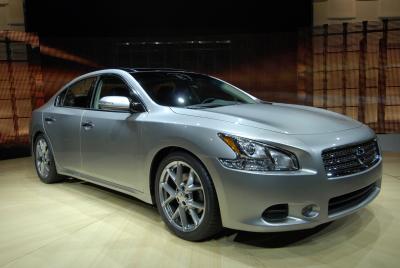
The Nissan Maxima comes with front disc brakes, but may also feature rear disc or rear drum brakes. While replacing the front or rear rotors requires a slightly different procedure, the overall concept remains the same. Generally, it's a good idea to replace pads when replacing the rotors; however, this is not always necessary depending on the symptoms you're experiencing. Rust pits, scores, grooves or any other surface deviations on the rotors will emit an adverse side effect felt when applying the brakes.
Remove 1/3 of the brake fluid from the master cylinder with a clean hand pump and pump the fluid into a tin can. Discard the fluid and replace the master cylinder cap.
Loosen the lug nuts (front tires or rear, depending on which rotors you're replacing) 1/8 turn counterclockwise with the lug nut wrench before lifting. Take note that if you're replacing the rear rotors, do not apply the parking brake, but if you're replacing the front rotors, apply the parking brake.
Raise the Maxima with the jack and secure it onto jack stands. Remove the lug nuts and wheels.
Take the 6-inch C-clamp (front brakes only) and place the top of the clamp on the inner caliper housing the drive arbor of the clamp on the backing plate of the outboard pad. Slowly tighten the clamp to compress the caliper piston into the caliper bore.
Remove the two caliper mounting bracket bolts located on the rear of the knuckle with a ratchet and socket. If you're replacing pads too, you'll need to separate the top of the caliper from the mounting bracket. However, if you're just changing the rotors, you can remove the caliper as an assembly and save some time. Hang the caliper from a hook to the strut spring to prevent damage to the rubber brake hose. For rear rotor replacement, remove the caliper and mounting bracket separately.
Remove the rotor. If the rotor is stuck to the hub, spray penetrating lubricant along the center of the hub where the rotor and hub meet. Allow a few minutes to penetrate and then use a hammer to strike the back of the rotor in several locations to break it free from the hub.
Clean the surface of the new rotor with brake cleaner spray. Spray both the front and back of the rotor to remove the rust preventative coating. Wipe the rotor dry with a shop rag.
Clean the edges and hub face using fine grit sandpaper to remove any rust build-up.
Place the new rotor on the hub.
Compress the rear caliper piston using a caliper piston reset tool and turn it into the bore clockwise until fully seated. Reattach the caliper mounting bracket and tighten the bolts. Replace the pads and caliper. Replace and tighten the caliper bolts.
Replace the caliper and mounting bracket bolts (front wheels only). Tighten the bolts to 75 foot-pounds with a torque wrench and socket. Be sure to replace rotors in sets so repeat this procedure for the other wheel on the same axle.
Replace the wheels and lug nuts. Tighten the lug nuts snugly, lower the Maxima and then torque the lug nuts to 80 foot-pounds using the torque wrench and socket. Tighten the lug nuts in a star or cross pattern.
Pump the foot brake pedal several times until it feels firm and then recheck the fluid in the master cylinder. Add only new brake fluid to the fill line and then replace the cap. Test-drive the Maxima for proper braking operation.